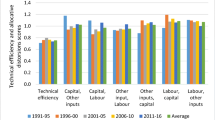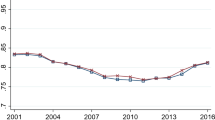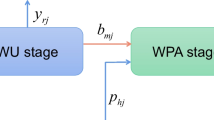Abstract
Low industrial water use efficiency has become a resource bottleneck to industrial development in China. The SBM-undesirable and meta-frontier models were used in combination with empirical data in 30 provinces in mainland China (Tibet excluded due to data missing from 1999 to 2013), to compare industrial water use efficiency in mainland China under meta-frontier and group-frontier, and explore the influencing factors. The empirical results of the study reveal that: (a) there is a large difference in the industrial water use efficiency between meta-frontier and group-frontier in mainland China, due to the heterogeneity in the levels of industrial water use technology; (b) given the low recycle rate of polluted industrial water, there is room for improvement in the industrial water use efficiency in the 30 provinces in mainland China. Further, the study finds that the current price of industrial water is distorted to some extent, failing to coordinate with the use of water resources. Policy implications indicate that industrial water use efficiency is not only related to technological heterogeneity in different regions, but also the control and treatment of industrial water pollution. Therefore, the current price of industrial water should be gradually raised. A scalar water pricing system as residential water could also be applied to industrial water.





Similar content being viewed by others
Notes
The authors selected 13 provinces as DMUs and indicators of three inputs and three outputs. The number of DMU is less than twice the product of the number of input and output variables.
The east group includes Beijing, Tianjin, Hebei, Liaoning, Shanghai, Jiangsu, Zhejiang, Fujian, Shandong; the central group includes Shanxi, Jilin, Heilongjiang, Anhui, Jiangxi, He’nan, Hubei, Hu’nan; the west group includes Inner Mongolia, Guangxi, Chongqing, Sichuan, Guizhou, Yunnan, Shaanxi, Gansu, Qinghai, Ningxia, Xinjiang.
The shadow price of industrial water can be interpreted as the economic cost of industry when reducing unit water consumption and reflects the marginal cost of industrial water.
References
Anderson, T. W., & Hsiao, C. (1982). Formulation and estimation of dynamic model using panel data. Journal of Econometrics, 18, 47–82.
Bathla, S. (1999). Water resource potential in northern India: Constraints and analyses of price and non-price solutions. Environment, Development and Sustainability, 1(2), 105–121.
Battese, G. E., O’Donnell, C. J., & Rao, D. S. P. (2004). A meta-frontier frameworks production function for estimation of technical efficiency and technology gap for firms operating under different technology. Journal of Productivity Analysis, 21(1), 91–103.
Battese, G. E., & Rao, D. P. (2002). Technology gap, efficiency, and a stochastic metafrontier function. International Journal of Business and Economics, 1(2), 87–93.
Chowdhury, S., & Al-Zahrani, M. (2014). Fuzzy synthetic evaluation of treated wastewater reuse for agriculture. Environment, Development and Sustainability, 16(3), 521–538.
Coggins, J. S., & Swinton, J. R. (1996). The price of pollution: A dual approach to valuing SO2 allowances. Journal of Environment Econometrics Management., 30(1), 58–72.
Dyson, R. G., Allen, R., Camanho, A. S., et al. (2001). Pitfalls and protocols in DEA. European Journal of Operational Research, 132, 245–259.
Fujii, H., Managi, S., & Kaneko, S. (2012). A water resource efficiency analysis of the Chinese industrial sector. Environmental Economics, 3(3), 82–92.
Honoré, B. E. (1992). Trimmed LAD and least squares estimation of truncated and censored regression models with fixed effects. Econometrica., 60(3), 533–565.
Hu, J. L., Wang, S. C., & Yeh, F. Y. (2006). Total-factor water efficiency of regions in China. Resources Policy., 31, 217–230.
Latinopoulos, D. (2009). Multicriteria decision-making for efficient water and land resources allocation in irrigated agriculture. Environment, Development and Sustainability, 11(2), 329–343.
Lee, M. (2005). The shadow price of substitutable sulfur in the US electric power plant: A distance function approach. Journal Environment Manage., 77, 104–110.
Liu, Y. H., & Wu, P. (2011). Energy consumption, carbon dioxide emission and regional economic growth in the APEC economies. Economic Review., 6, 109–120. (In Chinese).
Lu, L. (2008). Research on industrial water efficiency of Zhejiang province. Zhejiang: School of Economics, Zhejiang University. (In Chinese).
Malley, Z. J. U., Taeb, M., Matsumoto, T., & Takeya, H. (2008). Linking perceived land and water resources degradation, scarcity and livelihood conflicts in southwestern Tanzania: Implications for sustainable rural livelihood. Environment, Development and Sustainability, 10(3), 349–372.
Mwanza, D. D. (2003). Water for sustainable development in Africa. Environment, Development and Sustainability, 5(1–2), 95–115.
Pan, D., Huang, W., Wang, S. P., et al. (2011). DEA-based study on water use efficiency: A case study of Yunnan Province. Journal of Yangtze River Scientific Research Institute., 28(12), 15–18. (In Chinese).
Qian, W. J., & He, C. F. (2011). China’s regional difference of water resource use efficiency and influencing factors. China Population, Resource and Environment., 21(2), 54–60. (In Chinese).
Rao, D. S. P., O’Donnell, C. J., & Battese, G. E. (2003). Metafrontier functions for the study of inter-regional productivity differences. Working paper no. 01/2003, Centre for Efficiency and Productivity Analysis, School of Economics, The University of Queensland.
Rimawi, O., Jiries, A., Zubi, Y., & El-Naqa, A. (2009). Reuse of mining wastewater in agricultural activities in Jordan. Environment, Development and Sustainability, 11(4), 695–703.
Romano, G., & Guerrini, A. (2011). Measuring and comparing the efficiency of water utility companies: A data envelopment analysis approach. Utilities Policy., 19, 202–209.
Schneider, M., & Whitlatch, E. (1991). User-specific water demand elasticities. Water Resources Planning and Management, 117(1), 52–73.
Sun, A. J., Dong, Z. C., & Wang, D. Z. (2007). Prediction of technical efficiency and water consumption of industrial use water in China based on time series. Journal of China University of Mining & Technology, 36(4), 547–553. (in Chinese).
Sun, C. Z., & Liu, Y. Y. (2009). Analysis of the spatial-temporal pattern of water resources utilization relative efficiency based on DEA-ESDA in China. Resources Science, 31(10), 1696–1703. (in Chinese).
Tone, K. (2004). Dealing with undesirable outputs in DEA: A slacks-based measure (SBM) approach. Presentation at NAPW III, Toronto, pp. 44–45.
Yue, L., & Zhao, H. T. (2011). China’s water use efficiency of industry under environmental constraints based on data of 13 industrial regions during the period 2003 to 2009. Resources Science, 33(11), 2071–2079. (in Chinese).
Acknowledgments
The research is supported by the National Natural Science Foundation of China under Grants (Nos. 71103057 and 71473068). We greatly appreciate the assistance from Prof. Yanrui Wu at the Business School, University of Western Australia for our research.
Author information
Authors and Affiliations
Corresponding author
Appendix
Appendix
1.1 The derivation process of the shadow price of industrial water incorporating the industrial water pollution
The dual form of the SBM-undesirable model can be written as follows:
where s = s1 + s2, and denote v ∊ R m, u g ∊ R s1 and u b ∊ R s2 as the virtual price of input, desirable output and undesirable output, respectively. Similarly, this paper isolates the dual variable (V W ) of industrial water input from v. Assuming that absolute shadow price of the desirable output is equal to its market price, so the relative shadow price of industrial water compared with industrial production is as follows: \(p^{w} = p^{{y^{g} }} \cdot {{v_{w} } \mathord{\left/ {\vphantom {{v_{w} } {u^{g} }}} \right. \kern-0pt} {u^{g} }}\). It can be interpreted as water price per unit industrial output, or the reduced industrial output by saving per unit water (Coggins and Swinton 1996; Lee 2005). The shadow price can measure the real price of industrial water when it cannot be got directly or distorted seriously. This paper mainly compares the average price of 30 provinces in mainland China with the shadow price to investigate whether the current price of industrial water has been distorted. In addition, this paper explores its effect on industrial water use efficiency.
Rights and permissions
About this article
Cite this article
Li, J., Ma, Xc. Econometric analysis of industrial water use efficiency in China. Environ Dev Sustain 17, 1209–1226 (2015). https://doi.org/10.1007/s10668-014-9601-2
Received:
Accepted:
Published:
Issue Date:
DOI: https://doi.org/10.1007/s10668-014-9601-2




